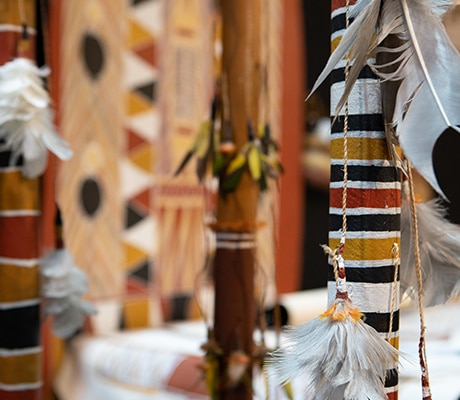June 22, 2020
![]() 3 mins Read
3 mins Read
For an art form with traditions and practices stretching back in a straight line through millennia, Australia’s Indigenous art scene is countering the current reality of travel restrictions and social distancing with a brilliantly modern approach. Leading the way is the celebrated Darwin Aboriginal Art Fair (DAAF), with this year’s event transitioning from its usual large gathering on Larrakia Country at the Darwin Convention Centre to an exclusively digital offering.
The quality of the art, and the depth of the program, will remain resolutely the same.

Darwin Aboriginal Art Fair. (Image: Dylan Buckee)
A highlight on the Northern Territory’s expansive yearly events calendar, DAAF’s significance to both artists and the public is huge. Now in its 14th year, the art fair has become one of the largest gatherings of established and emerging Aboriginal and Torres Strait Islander artists in the country, providing an invaluable opportunity for Indigenous-owned art centres across Australia and the Torres Strait to showcase their works to an engaged and appreciative audience.

Tangentyere artists and Yarrenyty Arltere artists booth at the 2019 Darwin-Aboriginal art fair. (Image: Dylan Buckee)
It also allows that same audience to purchase world-class art in an ethical manner; DAAF, staged by the not-for-profit Darwin Aboriginal Art Fair Foundation, does not collect commission on works sold, so 100 per cent of the money made (some $11.6 million in the last five years) goes directly to the artists and their communities.
In addition to providing a marketplace for Indigenous art, the fair is a dynamic cultural gathering designed to celebrate culture and traditions.

Performance by the Tiwi dancers dance troupe. (Image: Dylan Buckee)
The 2020 virtual fair, from August 6–14, will feature artworks in a range of styles and mediums, from works on canvas and paper to bark paintings, sculpture, didgeridoos, fibre art and cultural regalia, as well as an inspiring program of workshops, food experiences, dance and musical performances, and a children’s art project, all staged on DAAF’s website and social channels. Artworks will be available to purchase through online exhibition portals that will connect Indigenous artists and art centres with buyers from around the world.
This year’s fair will also include the inaugural National Indigenous Fashion Awards in August, which will be telecast on TV and digital channels.

From Country to Couture 2019 – Julie-Shaw, MAARA Collective x Bula’bula Aboriginal Arts.
While the move towards a virtual format for 2020 offers a vital continuity, both economically and creatively, for Indigenous artists and art centres, it also provides the opportunity to inspire an ever-increasing audience of art lovers, according to DAAF executive director, Claire Summers.
“By moving to a digital platform, we can reach a truly global audience and help people from all walks of life explore the wonderful world of Aboriginal and Torres Strait Islander art and design,” says Summers.

Elcho Island Arts booth at 2019 Darwin Aboriginal Art Fair. (Image: Dylan Buckee)
For the  best travel inspiration delivered straight to your door.
best travel inspiration delivered straight to your door.
LEAVE YOUR COMMENT